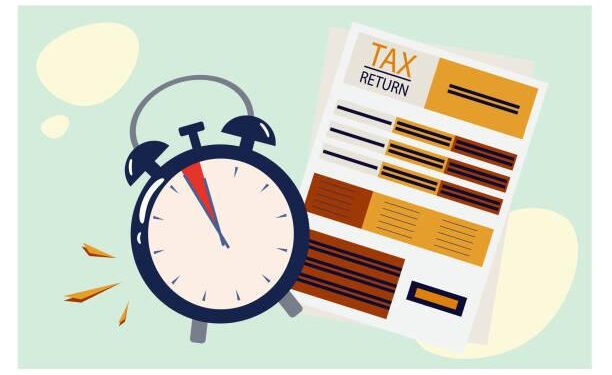If you are a US citizen and have submitted your federal tax return and are checking the IRS “Where’s My Refund? Tool” to find out the status of your refund, you may have seen a message that “your return is being processed.” In some cases, this message might pop up there for weeks or even months. This message may seem annoying to you, but it should still feel like a blessing in disguise as it tells the IRS (Internal Revenue System) receives your tax return.
As Howard Samuels, a certified public accountant at New Jersey-based Samuels & Associates, told the Acorns, “Receiving this message means the IRS got your tax return, so you do not have to sweat that there was an issue with them receiving it.” In retrospect, the IRS has been processing most returns within 21 calendar days of receiving the return.
As the 2022 tax season is roughly one month in, some early tax filers have already received their tax refunds. While the IRS faces an unprecedented backlog and pandemic staffing issues, it says you can still expect your refund money to arrive within 21 days of filing your tax return. Around 24 hours after a filer submits to the agency, you can start tracking the status of your refund using free IRS tools.
The IRS recommends you file taxes electronically and set up deposits this year around. IRS Commissioner Chuck Rettig announced in a January 24 statement, “Filing a paper tax return this year means an extended refund delay.” Taxpayers claiming the earned income tax credit or additional child tax credit also get a slight delay as the IRS expects those refunds to arrive nearby on 1st March. To equip yourself with more on this topic, read more!
The IRS is responsible for sorting your filings and will do so as efficiently as possible, assuming all tax and appropriate details are in order. Millions of people have already filed their tax returns to the IRS, hoping to receive a tax refund as soon as possible. This year households across the US expect to receive higher refunds due to the remaining balance of the child tax credit and the ability to claim the third stimulus checks if you never received them.
As the tax agency faces an increase in the backlog of paper returns, it is urging filers to submit as quickly as they can to avoid seeing delays in their refund. However, while filing on or before the recommended deadline, the IRS also warned against filing “prematurely” as mistakes can cause severe delays in reviving your refund.
Tax refund status
Using the IRS tool “Where’s My Refund,” go to the get refund status page, enter your data, then press Submit. If you entered your information correctly, you would move to the next page that shows your refund status. If not, you may need to verify your tax data and try again. If all the information looks correct, you will need to enter the date you filed your taxes, along with whether you filed electronically or on paper.
“Where’s my refund” has information on the most recent tax refund that the IRS has on file within the past two years, so if you are looking for return information from previous years, you will need to check your IRS online account for more details.
Using your own personalized account, you will be able to see the total amount you owe, your payment history, essential information about your most recent tax return, notices you have received from the IRS, and your address on file. The tracker displays progress through three stages:
- Return received
- Refund approved
- Refund sent
To use “Where’s My Refund,” you can visit IRS.gov and click on the “Check My Refund Status” link. You can also call the IRS refund hotline six weeks after mailing a return or 21 days after e-filing to find out the status of your refund. You need to provide your social security number, filing status, and the exact whole dollar amount of your refund to use the tool. If you call the IRS, you should have the following information ready when you ask about your tax return’s status:
- Social Security number and birthdate
- Filing status: Are you single, married, or head of household?
- Any prior communications from the IRS
If your refund status shows that your refund has been sent, but you did not receive it, there are some additional steps you will need to take depending on the method you were to receive your tax refund to locate and receive the money:
Tax refund by check
If you were getting your refund by check, it is possible the check was lost or stolen in the mail. You will need the IRS to trace the refund for you. If your tax filing status is married filing jointly, complete IRS Form 3911 (Taxpayer Statement Regarding Refund) and mail it to the same IRS service center where you would file your paper return.
If your tax filing status is single, head of household, or married filing separate, call the IRS refund hotline and report your refund as lost via the automated system or while speaking to an IRS representative or use the “Check My Refund Status” link on the IRS website, or the IRS2Go mobile app to request a trace for a paper check refund that has not been received.
Tax refund by direct deposit
If you were supposed to get your refund via direct deposit and have not after 21 days, you could have made a mistake entering your bank account number and routing number. If you have made errors on your return, the IRS does not have to fix them for you, so you will need to call your bank to find out what to do in this situation. If your bank is unwilling to help, file IRS Form 3911 with the IRS for help getting the funds returned to you.
How long will it take the IRS to send my tax refund?
The IRS usually issues tax refunds within three weeks, but some taxpayers could have to wait a while longer to receive their payments. If there are any errors in your tax return, the taxpayer might have to wait longer.
When a taxpayer’s return gets delayed due to an issue, its solution depends on how quickly and accurately a taxpayer responds. The ability of IRS-trained staff working under social distancing requirements due to covid-19 to complete the return processing is also an essential factor.
The date to receive a tax return also depends on your method of filing a tax return. According to the IRS, you will receive your return within six to eight weeks after processing if you submit a tax return. If your tax refund goes into your bank account via direct deposit, it may take an additional five days for your bank to post the money to your account.
If it takes the IRS 21 days to issue your check and your bank takes five more days to post it, you could be waiting a total of 26 days to get your tax refund. However, online services like “Venmo” and “Cash App” can deliver your tax refund a few days sooner since there is no waiting period for the direct deposit.
Tax return still being processed after 3 months
There are many reasons your tax refund could have been delayed. Perhaps your numbers and your employer’s numbers did not match, or you accidentally skipped a line or an entire form, or maybe you claimed a credit that the IRS takes longer to check. However, this year, the most likely reason your tax refund is delayed is that you filed a paper return. There was an additional backlog of tax returns created by the COVID-19 pandemic.
While IRS workers have been back at work for a while, there is always a chance this is still impacting your return. Of course, the reasons for a delayed tax refund before the covid-19 crisis may still apply. If it has been three months since you filed your tax return, and you receive a message that your tax return is still being processed, you need to call at IRS’s hotline that provides relevant information.
Reasons you haven’t received your tax refund
Delays in tax refund could trigger anxiety as the filer might need the money to meet a significant expense. Most Americans would have received their tax returns already by this time around. However, sometimes, a tax return gets delayed by a few cases; although a filer affirms to do everything right, there are still some common reasons that could delay your tax return. Let’s discuss these reasons briefly to present you with an overview.
Your tax return has errors or is incomplete
Whenever you file a tax return, you must cross-check every minor to significant detail you have provided. Providing accurate information is mandatory to receive your tax return on time; otherwise, you will wonder, “why is my tax return still being processed.?” Before you submit your taxes to the IRS, simply take a second look to fix any potential errors and make sure to fill out each section.
Moreover, if you received child tax credit payments last year, make sure the “Letter 6419” amount matches the amount you received. If you enter incorrect information, the IRS will need to review further your tax return, which subsequently leads to extensive delay.
Your bank’s information is incorrect
If you have changed bank accounts since you last filed your taxes, you must pay close attention to what the direct deposit information says when submitting your return this year. If you accidentally forget to update it with your new direct deposit details, the agency will return your refund to the IRS. This will likely result in mailing a paper check to your house, which could take several weeks longer to arrive.
You filed a paper tax return
The IRS encouraged taxpayers to file electronically and set up direct deposits to avoid delays and receive their tax returns sooner. Due to mail delays, it could take a while for the IRS to receive your return in the mail and even longer to issue a paper check.
Hence, filing your return online instead of through the mail is more important than ever this year to avoid refund delays. Instead of a paper tax return, use free online tax filing services available online on different platforms, so you do not have to wait to receive your money.
You filed for the child tax credit or earned income credit
The additional child tax credit is another refundable tax credit that could help anyone who qualifies for the regular child tax credit and has earned income of at least $3,000. Whereas earned income credit (EIC) is a refundable tax credit that benefits low to moderate-income workers and families.
If you filed your return in January and included the child tax credit or earned income credit on your taxes, by law, the earliest you can get a refund is mid-February. Due to the higher number of frauds with these reliefs, the IRS takes a bit longer to prevent the issuance of fraudulent refunds. Assuming there are not any errors, the IRS expects most taxpayers claiming these benefits to receive their refunds in their bank accounts by the start of March.
The IRS suspects identity theft
If the IRS flags a tax return for possible identity theft, the agency will hold your refund until your identity is verified. When that occurs, you will likely receive a 5071C letter that provides instructions for proving your identity. If your tax return is legitimate, you need not panic as an IRS letter does not mean there is proof of identity theft, merely a suspicion.
Taxpayers can verify their identity on the IRS website, which requires creating an ID.me account or calling a dedicated phone number listed on the IRS letter. If those methods fail, you will need to schedule an in-person appointment at a local IRS office. One way for avoiding identity-theft-related delays is to create an “Identity Protection PIN” or IP-PIN. This unique six-digit ID is known only to you and the IRS and prevents anyone else from filing a return in your name.
The “IP PIN” will only last for one year. You will need to create a new one for each tax season if you want the same level of identity protection. You will need an ID.me account to create an “IP PIN” online, although it is possible to acquire an “IP PIN” using IRS Form 15227 available online and a telephone interview or in-person appointment.
Your return needs further review
If you get a message saying that your tax return needs further review by the IRS, you can expect your refund to arrive later than the average time of three weeks. For instance, if you receive a CP07 notice, it means the IRS has received your tax return. However, it holds your refund until it completes a more thorough review. If you claim treaty benefits or deductions on the schedule A section of your taxes, you might get this notice.
If the agency declares no issues, your refund could arrive within six to 12 weeks, assuming you owe no taxes. If the IRS does find problems with your return, it will send you a notice with instructions on what to do within that same period. That means you will get your refund months later than you anticipated.
Avoid tax refund delays in 6 simple ways
After preparing your tax return and discovering you will get a refund, you might start planning how to spend or save it. But mistakes on your 1040 can keep you waiting for that refund. “When your return is right to start with, the chances that you’ll get your refund quickly go way up. Likewise, the chances that you’ll get a letter from the IRS go way down — and that’s always good news,” says IRS spokesperson Eric Smith.
We evaluated and mentioned the common mistakes that can slow the processing of your tax return and get your refund. You must avoid these six errors to get your refund faster. However, according to AARP, you can avoid the delays by following six simple ways.
1. File online
The IRS urges everyone to file online returns rather than filing paper ones, especially if you want your refund faster. Most online filers who choose direct deposit should get their refunds within 21 days of filing. On the other hand, a paper return could result in an extended refund delay.
2. Make sure all your documents arrive before filing
This is especially true of income forms like W-2s and 1099s. If you do not include all of these on your return, you will end up with a different result than what the IRS has on file. This will trigger a notice from the agency that will delay your return and refund.
3. Report your child tax credit and stimulus payments accurately
If you received an advance CTC payment and other federal stimulus checks linked to COVID-19 relief in 2021, you would need to put the exact amounts on your return to avoid delays. The IRS is mailing unique letters about the money you received from the stimulus and CTC payments. Be sure to reconcile these amounts against what your records show to ensure an accurate return.
4. Claim the correct dependents
The main thing to look out for here is to ensure that the dependents you claim aren’t claiming themselves on their returns. If that happens, one of you will have to correct a return, which can cause delays. You also need to make sure you enter the correct Social Security number for each dependent.
5. Make sure you sign your return
As the IRS’s Smith told AARP, “Sending in an unsigned paper return is like sending in no return at all. At that point, it’s not valid.” The IRS will have to return it to be signed, and by the time you send it back, it could already be caught up in a huge backlog.
6. Sending your return to the wrong IRS processing center
The IRS will need to forward your return to the correct processing center, delaying when the agency’s staff can begin working on your filing. If you send it to the wrong center, the IRS will need to forward it to the right one, which puts you at the back of the line.
IRS offers tax filing tools
For those looking to file for free, those with a gross income of $73,000 a year or less can use the IRS’ “Free File Program.” According to the IRS, using this program is the fastest way to file electronically and receive your refund through direct deposit. All refunds will be distributed through direct deposit so long as they provide a routing and account number.
For filers with low incomes needing to correct an issue related to an audit or refund with the IRS’ the low-income taxpayer clinics (LITC). It helped secure more than $5.8 million in tax refunds and reduced or corrected taxpayers’ liabilities by over $116 million in the previous year. These clinics also worked with almost three thousand taxpayers to ensure they were up to date and compliant with the IRS.
Conclusion
By this, many US citizens have already sorted out their 2021 tax returns. However, there might still be those who are still waiting for their returns from 2020. Waiting for a tax return can make you anxious, and you must wonder every time it gets delayed, “why is my tax return still being processed.?” If you expect a tax refund, you must always file your tax return at your earliest. You must have a keen eye while providing every required information; otherwise, you will be facing delays.
Most delays in receiving your tax return are due to staple mistakes, which you can avoid by following the guidelines given by the department. There are tools available on the official website of the IRS that can help you track your tax return. Hence, be sure not to leave any room for mistakes to avoid delays in your tax return.









